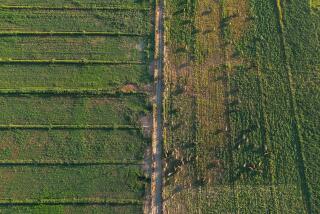OSHA, Pentagon Probing Health Concerns at Lockheed Plant
- Share via
Federal occupational health inspectors and a Pentagon team Thursday launched dual investigations of charges that workers at the Lockheed plant in Burbank--who are believed to be assembling top secret stealth fighter planes--are being sickened and killed by exposure to dangerous chemicals.
A three-person team from the Occupational Safety and Health Administration, led by the director of the agency’s Southern California operation, went to the Lockheed plant Thursday, said a spokesman for OSHA regional headquarters in San Francisco.
In Washington, Rep. Howard Berman (D-Panorama City) announced that the Pentagon will promptly send a team of military physicians, toxic material experts and other specialists to the plant.
The Department of Defense said that the team “will be out there by Monday,” according to a spokeswoman for Berman, who represents the area where the plant is located.
“They’ll talk with the plaintiffs, examine the workplace and do their best to find out precisely what’s happening,” she said.
Called ‘a Great Idea’
About 75 Lockheed workers have brought a lawsuit against their employer and firms involved in producing and supplying the chemicals. About 150 have filed worker’s compensation claims, complaining that they suffer from ailments brought on by exposure to hazardous substances.
The workers, some of them from Lockheed’s highly classified “skunk works,” have complained that they are handicapped in seeking treatment from private physicians because security regulations forbid them to discuss their work with outsiders.
Aviation observers believe the skunk works is producing a stealth fighter, sometimes called the F-19, although the Defense Department has not acknowledged the existence of such a plane. Aviation analysts say that stealth planes are constructed largely from exotic composite materials--which have the strength of metals but do not reflect radar pulses--and require use of hazardous chemicals to manufacture and shape.
Defense Department spokesmen said no information was available about the current health investigation. Lockheed spokesman Jim Ragsdale confirmed that the company “got preliminary word today that something like that was being planned by the Defense Department” but had been given no details.
No OSHA Inspection
The Pentagon investigation was praised as “a great idea,” by Bryan Carver, president of District 727 of the International Assn. of Machinists and Aerospace Workers, which represents about 6,500 Lockheed employees, including most of those involved in the lawsuit and worker’s compensation claims.
Berman said that following widespread news reports about the Lockheed workers’ lawsuit, he asked the Defense Department to assign military physicians with security clearances to investigate in order to remedy complaints that the workers cannot discuss their medical problems without violating laws against disclosing classified information.
Berman’s office said the Pentagon had also agreed to expedite a security clearance for an inspector from OSHA.
High-ranking OSHA sources said this week that in the 16 years since the agency was founded no state or federal OSHA inspector has ever conducted a full-scale inspection of the skunk works.
State occupational health inspectors were turned away in 1973 from the plant for lack of security clearances, and federal inspectors who took over the job conducted narrowly focused inspections, checking only on specific complaints, according to a high-level OSHA source.
“It doesn’t appear there has ever been a wall-to-wall inspection, either by the state or the feds,” the source said.
He said federal inspectors had checked on specific complaints at the Lockheed plant in Burbank 10 times since the agency was founded in 1972 and reported “less than 20 violations.”
“If that (number of violations) had been from nine wall-to-wall inspections that would be exceptionally good,” he said, but in the absence of more thorough inspections the record is “a little too good to be true . . . It means we don’t have a true reflection of the facts.”
An OSHA spokesman said Thursday that a three-person team went to the Lockheed plant earlier that day--by law, companies are not warned that OSHA inspectors are coming--and conferred with Lockheed executives. The team was led by Frank Gravitt, OSHA director for the Southern California area, “which is not something that happens routinely,” the spokesman said.
An inspector flown in from Salt Lake City, who already had a nuclear-materials security clearance from the Department of Energy, “was admitted to the secure portion of the plant and will be returning for several days,” the spokesman said.
“He will look first into the specific complaints contained in the lawsuit and media reports and after that will decide whether to expand this into a wall-to-wall general inspection.”
Between 70 and 80 Lockheed employees have filed suit against the company in Superior Court in Burbank, charging that they have been made ill by exposure on the job to chemicals and dust particles, according to their attorney, Timothy Larson of Encino.
Larson, who said he did not know the exact number of plaintiffs, said he also represents about 150 Lockheed employees in related worker’s compensation cases.
The workers are suffering from ailments ranging from skin rashes and soreness to cancer, Larson said.
Five of his clients, and an unknown number of other workers, have died since he took the first worker’s compensation cases in February of 1986, Larson said, but he would not identify the dead, saying he was ethically bound to protect the privacy of their families.
More to Read
Sign up for Essential California
The most important California stories and recommendations in your inbox every morning.
You may occasionally receive promotional content from the Los Angeles Times.










